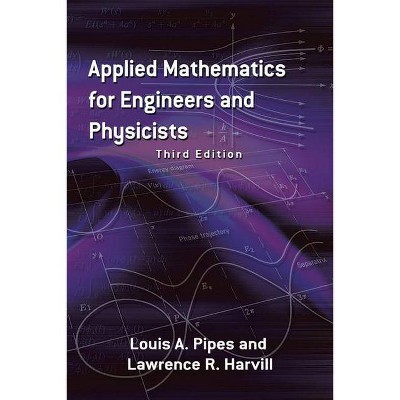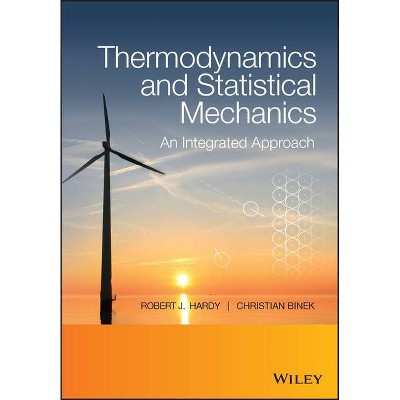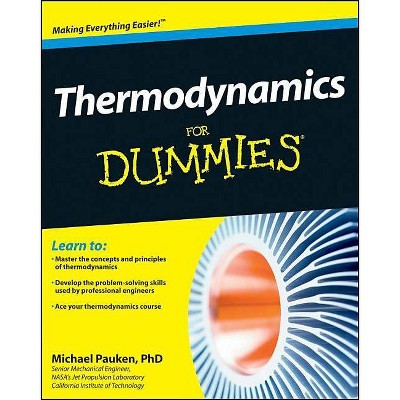Thermodynamics for Chemists, Physicists and Engineers - by Robert Holyst & Andrzej Poniewierski (Paperback)

Similar Products
Products of same category from the store
AllProduct info
<p/><br></br><p><b> About the Book </b></p></br></br><p>Written by two recognized experts in soft matter research, this volume presents an elementary introduction to the thermodynamics taught in undergraduate courses. It explains basic concepts and details the applications of the laws to a number of systems.</p><p/><br></br><p><b> Book Synopsis </b></p></br></br><p><b>Dedication.- Preface.- Part I: Foundations of thermodynamics.- 1 Historical introduction</b>.- <b>2 Basic concepts and definitions.- </b>2.1 Concept of thermodynamic equilibrium.- 2.2 Extensive parameters of state.- 2.3 Intensive parameters of state.- 2.4 Equations of state.- Exercises.- <b>3 Internal energy, work and heat.- </b>3.1 First law of thermodynamics.- 3.2 Isochoric process.- 3.3 Isobaric process.- 3.4 Adiabatic process.- 3.5 Isothermal process.- 3.6 Evaporation of liquids.- 3.7 Chemical reaction.- Exercises.- <b>4 Entropy and irreversibility of thermodynamic processes.- </b>4.1 Second law of thermodynamics.- 4.2 Conditions of thermodynamic equilibrium.- 4.3 Entropy as a function of state parameters.- 4.4 Changes in entropy in reversible processes.- 4.5 Heat devices.- 4.6 Changes in entropy in irreversible processes.- 4.7 Third law of thermodynamics.- Exercises.- <b>5 Thermodynamic potentials.- </b>5.1 Legendre transformation of the internal energy and entropy.- 5.2 Natural variables.- 5.3 Free-energy minimum principle.- 5.4 Examples of application of thermodynamic potentials.- 5.5 Intrinsic stability of a system.- Exercises.- <b>Part II: Phase transitions.- 6 Phase transitions in pure substances.- </b>6.1 Concept of phase.- 6.2 Classification of phase transitions.- 6.3 Conditions of phase coexistence.- 6.4 Phase diagrams.- 6.5 Two-phase coexistence lines.- 6.6 Liquid-vapour two-phase region.- 6.7 Van der Waals equation of state.- Exercises.- <b>7 Mixtures.- </b>7.1 Basic concepts and relations.- 7.2 Intrinsic stability of a mixture.- 7.3 Partial molar quantities and functions of mixing.- 7.4 Mixture of ideal gases.- 7.5 Ideal mixture.- 7.6 Real mixtures.- 7.7 Phase rule.- Exercises.- <b>8 Phase equilibrium in ideal mixtures.- </b>8.1 Liquid-gas equilibrium.- 8.2 Liquid-solid equilibrium.- 8.3 Osmotic equilibrium.- 8.4 Colligative properties.- Exercises.- <b>9 Phase equilibrium in real mixtures.- </b>9.1 Liquid-vapour equilibrium.- 9.2 Liquid solutions with miscibility gap.- 9.3 Liquid-vapour equilibrium in presence of miscibility gap.- 9.4 Liquid-solid equilibrium and solid solutions.- Exercises.- <b>Part III: Chemical thermodynamics.- 10 Systems with chemical reactions.- </b>10.1 Condition of chemical equilibrium.- 10.2 Effect of external perturbation on chemical equilibrium.- 10.3 Law of mass action for ideal gases.- 10.4 Thermochemistry.- 10.5 Phase rule for chemical systems.- Exercises.- <b>11 Electrochemical systems.- </b>11.1 Electrolyte solutions.- 11.2 Aqueous solutions of acids and bases.- 11.3 Electrochemical cells.- 11.4 Reversible cell.- Exercises.- <b>Solutions </b>.- <b>References.- Index.</b></p><p/><br></br><p><b> From the Back Cover </b></p></br></br><p>Thermodynamics is an essential part of chemical physics and is of fundamental importance in physics, chemistry and engineering courses. This textbook takes an interdisciplinary approach to the subject and is therefore suitable for undergraduates in all those courses. The book is an introduction to phenomenological thermodynamics and its applications to phase transitions and chemical reactions, with some references to statistical mechanics. It strikes the balance between the rigorousness of the Callen text and phenomenological approach of the Atkins text. The book is divided in three parts. The first introduces the postulates and laws of thermodynamics and complements these initial explanations with practical examples. The second part is devoted to applications of thermodynamics to phase transitions in pure substances and mixtures. The third part covers thermodynamic systems in which chemical reactions<br>take place. There are some sections on more advanced topics such as thermodynamic potentials, natural variables, non-ideal mixtures and electrochemical reactions, which make this book of suitable also to post-graduate students.</p><p>Robert Holyst (1963) is a professor at the Institute of Physical Chemistry Polish Academy of Sciences. He specializes in statistical physics, physical chemistry, biologistics and soft matter physics. He has published 182 papers and 2 books. He presented his works at multiple universities/institutes, e.g. Harvard, MIT, University of Chicago, ESPCI-Paris, ENS-Paris, several Max Planck Institutes, University of Tokyo, Oxford and Cambridge. He has over 17 years experience in teaching thermodynamics for undergraduate students.</p><p>Andrzej Poniewierski (1951), professor at the Institute of Physical Chemistry Polish Academy of Sciences; published 53 papers and two books, specializes in soft matter and statistical physics, liquid crystals and applications of density functional theory to complex fluids. He has also taught thermodynamics for undergraduate students for several years. <p/></p><p></p><p/><br></br><p><b> Review Quotes </b></p></br></br><br><p>From the reviews: </p><p>"This book by Holyst and Poniewierski (both, Polish Academy of Sciences) is an introduction to 'phenomenological' thermodynamics, and a recent addition to a long list of books on this subject. ... One of the most appealing aspects of the book is the end-of-chapter exercises along with the detailed solutions in the appendix. ... The material is appropriate for second-year students in the sciences and engineering ... . Summing Up: Recommended. Lower-division undergraduates." (R. Darby, Choice, Vol. 50 (5), January, 2013)</p><p>"The book is divided into 11 chapters, each of them ending with a long series of exercises, whose detailed solutions are gathered at the end of the book in more than 100 pages. ... the book contains several pictures which illustrate the different notions which are introduced. Thus doing, the material which is contained is accessible to different kinds of readers. Chemists will find the useful bases concerning thermodynamical systems. Mathematicians will get acquainted with applications to chemical processes." (Alain Brillard, Zentralblatt MATH, Vol. 1260, 2013)</p><br><p/><br></br><p><b> About the Author </b></p></br></br><p>Robert Holyst (1963) is a professor at the Institute of Physical Chemistry Polish Academy of Sciences. He specializes in statistical physics, physical chemistry, biologistics and soft matter physics. He has published 182 papers and 2 books. He presented his works at multiple universities/institutes, e.g. Harvard, MIT, University of Chicago, ESPCI-Paris, ENS-Paris, several Max Planck Institutes, University of Tokyo, Oxford and Cambridge. He has over 17 years experience in teaching thermodynamics for undergraduate students.</p><p>Andrzej Poniewierski (1951), professor at the Institute of Physical Chemistry Polish Academy of Sciences; published 53 papers and two books, specializes in soft matter and statistical physics, liquid crystals and applications of density functional theory to complex fluids. He has also taught thermodynamics for undergraduate students for several years. <br></p>
Price History
Price Archive shows prices from various stores, lets you see history and find the cheapest. There is no actual sale on the website. For all support, inquiry and suggestion messages communication@pricearchive.us




















